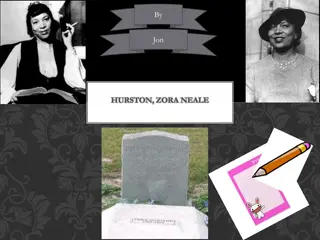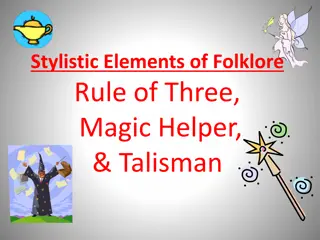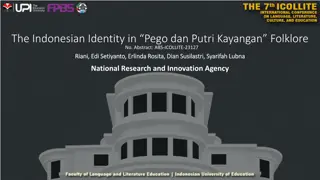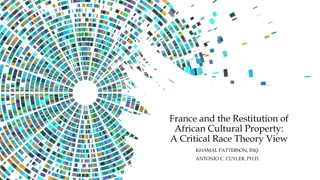African Folklore Influence in America: Retaining Cultural Identity and Resistance
Surviving pieces of African culture play a crucial role in maintaining pride, cultural identity, and resistance to oppression in America. Slavery aimed to erase the African culture brought by enslaved people, including forbidding their religions and drums. The Haitian slave revolution in 1791-1804, the use of folk tales like Brer Rabbit, and the practice of frame tales all illustrate how African folklore persisted and influenced American culture despite adversities.
Download Presentation

Please find below an Image/Link to download the presentation.
The content on the website is provided AS IS for your information and personal use only. It may not be sold, licensed, or shared on other websites without obtaining consent from the author.If you encounter any issues during the download, it is possible that the publisher has removed the file from their server.
You are allowed to download the files provided on this website for personal or commercial use, subject to the condition that they are used lawfully. All files are the property of their respective owners.
The content on the website is provided AS IS for your information and personal use only. It may not be sold, licensed, or shared on other websites without obtaining consent from the author.
E N D
Presentation Transcript
African Folklore in America Surviving pieces of African culture are very important as a source of pride, cultural identity and resistance to oppression. Slave system attempted to eradicate the culture Africans brought Tried to always mix tribal/language groups so they couldn t talk to each other Forbad their religions and drums Why? Haiti s slave revolution in 1791-1804 was the second revolution of the new world and scared the TAR out of the south. They communicated war plans from one plantation to the next with drums. Voodoo (Vodun, African religion) also figured prominently as a unifying religion that made them feel empowered. U.S. & Britain outlawed international slave trade in 1808, so no new people from Africa came into the U.S. Made it harder to keep cultural memory alive
Brer Rabbit Slaves preserved some of their traditions Trickster tales are about a weak character who wins every contest through cunning Obvious lesson for slaves on how to outwit the master/overseer Lessons in how to act and how to talk to those who think they have more power Brer Rabbit pretends fear and humility oh please don t throw me in the briar patch, I m begging you. Also a moment of appropriation and exploitation by Harris Used stories he got from slaves without acknowledgement or compensation (like Led Zepplin)
Frame Tale Definition An initial narrator (usually 3rdperson) presents a character in the story who tells an imbedded story to another character. 2 scenes one where story is being told, and that story itself, which is about a different time. Usually not much happens in the frame it s just a way of giving the other story a cultural context Framing devices tell readers where we might be expected to hear a story like this, whose tradition/experience it belongs to, and listeners in the story model an attitude toward the speaker & his message
Harris Frame Tale A little white boy hangs around the slave cabin and begs for stories This story belongs to Uncle Remus. Real storyteller was George Terrell and others (Too bad George never made any money off it). The scene is again a compensatory fantasy that has special appeal for white readers Readers see that slaves like Uncle Remus just LOVED little white boys Many literary critics have shied away from these stories because of this kind of paternalistic lie about slavery. Still very important
Does the story transcend the frame? Boy s attitude toward speaker? Doesn t recognize that uncle Remus is tired, has his own family to think about. Sense of entitlement, etc. Remus also has his own sense of trickery gets rid of the kid when he s had enough works in some fairly subversive messages. For those of us who are alert and not children, we can see Remus taking control of the situation to the extent he can. Which part of the message is stronger to you? Resistance or oppression?
Daves Neckliss Also a Frame Tale Where are we (time & place)? Whose tradition/experience is this? What is the attitude of the listeners (John & Annie) toward Uncle Julius & story itself? Write: How is Chesnutt s framing different than Harris s?























